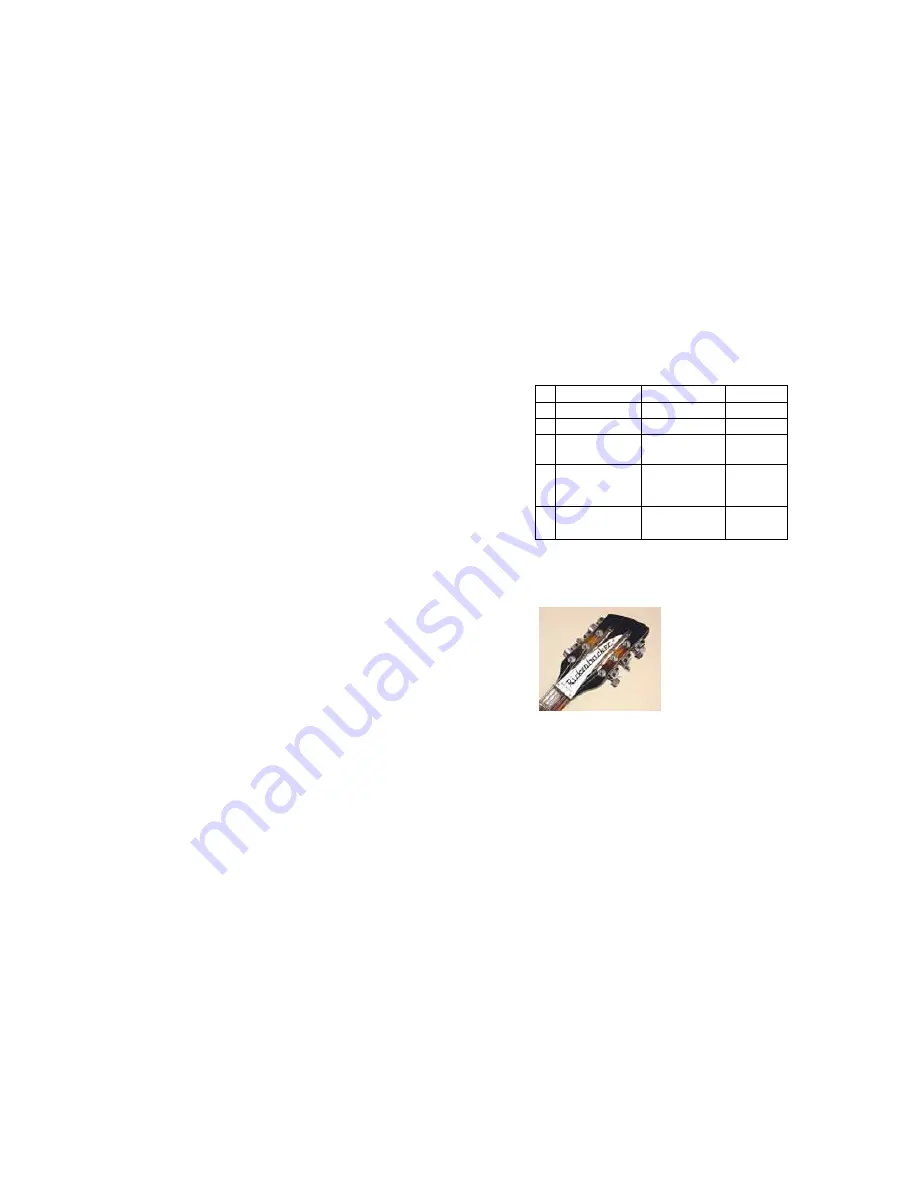
wish to use a mono or standard
cable, plug it into the standard jack
only.
To use with a quality stereo Y-cord,
insert the cable’s stereo plug into
the Rick-O-Sound output jack on
the instrument. Then, plug each of
the cable’s standard mono cables
into either 1) two separate amplifi-
ers, or 2) each channel of a dual
channel amplifier.
Rick-O-Sound provides a choice
between three different types of
effects at one time. With the pickup
selector on the bass pickup, Rick-
O-Sound puts out a lush and full
bass sound. With the pickup selec-
tor in the middle position, a beauti-
ful blend of highs and lows can be
achieved, much like a clean chorus
effect. The tonal separation is
improves when using two amplifi-
ers. With the pickup selector in the
treble position, Rick-O-Sound
produces a bright and full ringing
lead tone.
An example set-up might have a
soft, full jazz sound with plenty of
reverb at the bass setting in the
amplifier or channel one. Or a loud,
distorted heavy rock sound at the
treble position in the amplifier or
channel two. A big pop rock stereo
chorus type sound could come
from a combination of the two in
the middle position using both
amplifiers or channels.
The Rick-O-Sound may also be
used with a standard stereo cable
to connect directly with amplifiers
equipped with a stereo input.
A standard, quality shielded stereo
Y-cord, sometimes termed an
“insert cable”, is recommended for
use with ROS, but cables of poorer
quality may result in a significant
increase in noise or loss in treble
tone. Low capacitance and a high
degree of shielding comprise the
most important characteristics of a
quality cord.
Strings and tuning
All Rickenbacker instruments come
equipped with Rickenbacker
strings. These strings are specially
designed to bring out the best tonal
properties, playability and overall
fidelity in all Rickenbacker instru-
ments. The strings come on new
Rickenbacker instruments with a
factory specified gauge and ten-
sion, designed to provide optimum
performance. Moreover, each
Rickenbacker instrument is specifi-
cally adjusted for the type of string
provided. If a different gauge,
tension or brand of string is de-
sired, it may be necessary to
readjust the instrument. To avoid
readjustment of the instrument,
continue to use the RIC strings
designed for use on your model.
Check the string guide in this
manual for specific information.
Rickenbacker strings are made
specifically for your instrument.
String Replacement
When installing strings, the first
string should be loosened and
removed, and the new one in-
stalled and brought to pitch before
proceeding to the next string.
Replacing strings in this manner
keeps the adjustments in place.
Avoid stretching the string beyond
the intended pitch.
Proper string winding helps the
instrument stay in tune and pro-
duce proper intonation. On the first
turn, wrap the string over the
exposed string tip. This method
helps hold the string in place when
it is brought up to pitch. For un-
wound strings, wrap them at least
five times around the machine
head. For wound strings, three
times around should prevent string
slippage.
Some Rickenbacker guitars come
with no-hole slot tailpieces for easy
stringing. Simply slip the string
bead into its proper slot and pull
the string up to the key wind,
keeping tension on the instrument.
Then wind the string as discussed
above.
12 String Tuning
The most effective way to tune a
twelve string guitar is to begin by
tuning the regular six strings as
would be done on a six string
guitar. After these are brought to
pitch, proceed to tune the strings
that play in unison (the high E and
B set, or numbers 1 and 2).
Now proceed to tune the remaining
strings, which play at an octave
from their regular string partner.
The strings which play in unison
are of the same gauge, while the
strings that play at the octave are a
lighter gauge than the other string
of their pair. Sometimes it is neces-
sary to go back and repeat this
process again for perfect tuning.
Many newer Rickenbacker 12-
stringers now feature “slot-through”
peg heads, wherein the channels
for the “sideways” keywinds extend
through the back of the headstock.
This design makes it easier to
string and tune up 12-string mod-
els, as well as improving tone due
to decreased head weight.
Note that on some models the
strings touch the nameplate which
has no adverse effect.
String Guide
The table above shows the gauges
of strings which come on all Rick-
enbacker guitars and basses when
purchased from the factory.
Before changing strings, consult
the table to see what gauge string
each instrument was designed to
use and compare the gauges.
Heavier strings than the original
factory sets may require adjust-
ment of the neck and re-grooving
of the saddles and nut. Less ad-
justment may be needed if choos-
ing a lighter than standard set.
Any quality string set may be
utilized on a Rickenbacker guitar or
bass within a reasonable gauge
range as suggested by the chart
above. Perhaps the most important
characteristic of a quality string is
uniformity of diameter throughout
its length. The varying diameter of
a cheap or non-uniform strings
makes it impossible to adjust for
acceptable intonation. So-called
SKU Standard Factory Stringing
String Type
String Gauge
95106 All Short Scale Guitars
Short Scale NikL
12-16-24W-32-42-54
95403 Full Scale Six String Guitars
Compressed Round Wound
10-13-17-26-34-42
95404 All Twelve String Guitars
Compressed Round Wound
10-13-20-26-34-42
95511
95515
All Four String Bass Guitars
All Five String Bass Guitars
Round Wound NikL
Round Wound NikL
45-55-75-105
45-55-75-105-115
95405 Mandolin
Compressed Round Wound
10-13-26-36
10-13-26-36
Содержание Guitar and Bass
Страница 1: ...Guitar and Bass Care Maintenance Manual...








